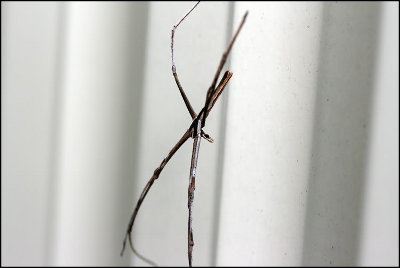Stick Spider
Category: Arachnida Spider

Facts about Stick Spiders, Stick Spider is a breed of spider that belongs to the Deinopidae family. The Stick Spider breeds are largely found all over the world, particularly in the tropics, ranging from Australia to Africa and most parts of America. The Stick Spider breeds are also referred to as the ogre-faced spider since it has two huge circular eyes similar to an ogre.
Appearance of Stick Spider
The Stick Spider breed appears similar to a tiny bunch of twigs when it relaxes during the daytime. The male Stick Spider breeds are smaller than the female ones and have big palps. The male Stick Spider appears with the body length of 12 mm, whereas the females have a body length of 25 mm. The Stick Spider breed has a rusty brown colored body with two bulges halfway down the stomach. The Stick Spider breed grips its legs in pairs so it appears as though the spider has four legs.
Features of Stick Spider
These are elongated stick-like spiders, which construct strange webs that they hang between the forelegs. When prey advances, the Stick Spider will make the net bigger to two or three times its comfortable size and impel itself onto the prey, entrapping it in the web. Their outstanding night-vision tailored posterior median eyes enable them to spread this web over likely prey items. These eyes are bigger than the other six eyes.
The Stick Spider breed mostly lives among bushes, tall grass and shrubs in cool places down creeks and streams or in the middle of rock shelters. The Stick Spider can as well be seen cities, in the bits of the high grass or flowers at the base of backyards.
Diet of Stick Spider
The Stick Spider breed feeds on butterflies, flies, beetles, pests and occasionally each other. The Stick Spider breed catches its prey at nighttime because there are many pests about and their eyes are excellent for night vision. The Stick Spider breed has developed a unique way of grabbing their prey. A Stick Spiders stomach can only take liquids, so a Stick Spider needs to liquefy their food before they eat. They bite on their prey and empty its stomach liquids into the pray which turns it into a soup for them to drink.
The average lifespan of the Stick Spider breed is up to three years in the wild.
A male Stick Spider has two appendages called "pedipalps" a sensory organ, instead of a penis, which is filled with sperm and insert by the male into the female Stick Spider’s reproductive opening.
Stick Spiders do not have a skeletons. They have a hard outer shell called an exoskeleton-(a rigid external covering for the body in some invertebrate animals). The exoskeleton is hard, so it can’t grow with the spider. The young Stick Spiders need to shed their exoskeleton. The Stick Spider has to climb out of the old shell through the cephalothorax. Once out, they must spread themselves out before the new exoskeleton will harden. Know they have some room to grow. They stop growing once they fill this shell. Female spiders are usually bigger than males.
Spiders belong to a group of animals called "arachnids", mites and Scorpions and a tick is also in the arachnid family. An Arachnids is a creature with eight legs, two body parts, no antennae or wings and are not able to chew on food. Spiders are not insects because insects have three main body parts and six legs and most insects have wings.
The Arachnids are even in a larger group of animals called "arthropods" an invertebrate animal of the large phylum Arthropoda, which also include spiders, crustaceans and insects. They are the largest group in the animal world, about 80% of all animals come from this group. There are over a million different species. There are more than 40,000 different types of spiders in the world.
Stick Spiders have oversize brains.
In Stick Spiders, oxygen is bound to "hemocyanin" a copper-based protein that turns their blood blue, a molecule that contains copper rather than iron. Iron-based hemoglobin in red blood cells turns the blood red
Stick Spiders have two body parts. First part of the body is the abdomen. The abdomens back end is where there is the spinnerets, where the silk producing glands are located. The Stick Spider’s body has oil on it, so the spider doesn't stick to it’s own spider web. Also Stick Spider’s gland that makes the poison, stomach, fangs, mouth, legs, eyes and brain are on this part of the body. The second part is the front part of the body this is called the Cephalothorax-(the thorax and fused head of spiders). Stick Spiders also have these tiny little leg-type things called (pedipalps) that are next to the fangs. They are used to hold food while the spider bites it.
The muscles in a Stick Spiders legs pull them inward, but the spider can't extend its legs outward. It will pump a watery liquid into its legs that pushes them out. A Stick Spider’s legs and body are covered with lots of hair and these hairs are water-repellent, which trap a thin layer of air around the body so the spiders body doesn't get wet. It allows them to float, this is how some spiders can survive under water for hours. A Stick Spider feels its prey with chemo sensitive hairs on its legs and than feels if the prey is edible. The leg hair picks up smells and vibrations from the air. Each spiders leg has six joints, giving the Stick Spider 48 leg joints.

 Back To Category Arachnida Spider
Back To Category Arachnida Spider